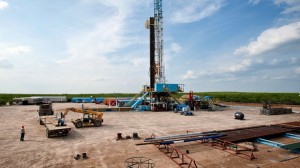By Dan Murtaugh Jan 31, 2014 2:12 PM CT
Source: Bloomberg
Near the only four-way stoplight in Nixon, Texas, smoke rises off a pilot flare at theBlue Dolphin Energy Co. (BDCO)refinery that had sat cold for two decades.
The employee parking lot is full, tanker trucks line up to unload crude and the silver distillation tower thrums. None of that was happening two years ago, when Blue Dolphin reopened the 10,000-barrel-a-day plant. Smaller refineries are known as “teapots” because of their size.
The reason for the resurrection is illustrated across the street — the Screaming Eagle 1H Well. It’s one of thousands in South Texas, making the Eagle Ford shale formation among the world’s fastest-growing oil patches. Blue Dolphin, Valero Energy Corp. (VLO), Kinder Morgan (KMI) Inc. and others are trying to capitalize on the biggest boom in U.S. history by building new crude-processing equipment, reviving mothballed plants and opening new refineries.
“We started this project in 2006, and I can’t tell you how many banks and other financing sources would ask us, ‘Where are you going to get your crude from?’” said Jonathan Carroll, Blue Dolphin’s chief executive officer. “We don’t get that question anymore.”
Directional drilling and hydraulic fracturing in shale formations such as the Eagle Ford and the Bakken in North Dakota helped U.S. oil production grow by a record 1.136 million barrels a day last year to 8.121 million, according to the Energy Information Administration.
Discounted Oil
That and restrictions on exporting crude have reduced the cost of American oil relative to the rest of the world. U.S. benchmark West Texas Intermediate settled at $97.49 a barrel, compared with $106.40 for European Brent.
The discount has been a boon to U.S. refiners. The top three performers on the S&P 500 Energy Index since the beginning of 2012 are all refining companies: Valero, Marathon Petroleum Corp. (MPC) and Tesoro Corp. (TSO)
It’s also crimped profit for producers such as ConocoPhillips (COP) and billionaire Harold Hamm’s Continental Resources Inc. (CLR), which have argued for easing export rules. U.S. refineries are better suited for heavier oil than the light, sweet crude that comes from shale deposits, they say.
Companies will add 500,000 to 830,000 barrels a day of crude and condensate processing capacity to handle more light oil over the next five years, according to projections from Dallas-based Turner, Mason & Co. and Dallas-based Baker & O’Brien, Inc. It’s the largest gain in light-oil refining capacity “since the early days of U.S. oil production,” said Rick Thomas, a consultant with Baker & O’Brien.
Light Crudes
When that capacity comes online, it will absorb some of the excess light oil that producers want to ship abroad, said Andy Lipow, president of Houston-based Lipow Oil Associates LLC.
The Nixon refinery was built in 1980, primarily to supply Air Force bases in the San Antonio area with jet fuel, Carroll said. It shut around 1990.
Carroll began looking at the plant in 2006, a year after Hurricanes Katrina and Rita knocked more than 30 percent of U.S. refining capacity offline. The financial crisis delayed funding of the project, and by the time it started operating, the Eagle Ford was producing about 451,000 barrels of crude and condensate a day, according to EIA data.
Eagle Ford
“The Eagle Ford has created its own marketplace,” Carroll said. “It’s changed the course for others, and specifically for us, because we’re right in the middle of it, wells are literally across the street.”
The refinery contracts with Genesis Energy LP (GEL) to purchase oil that it processes into jet fuel, diesel used by drillers and feedstock sold to nearby refineries.
Blue Dolphin also has an option to purchase an idled 40,000-barrel-a-day refinery in Ingleside, Texas, near Corpus Christi. Small plants like the ones Blue Dolphin is targeting are simpler to reopen because they can get all their crude via tanker truck and have lower emissions than larger plants, making it easier to get environmental permits, Carroll said.
Continental Refining Co. restarted in late 2012 a 5,500-barrel-a-day refinery in Somerset, Kentucky, that was idled in February 2010 when the previous owner couldn’t secure crude supplies. Continental runs mostly locally produced oil, and can also get Bakken crude by rail or barge, Missy Shorey, an outside spokeswoman for Continental based in Wichita Falls, Texas, said when the plant reopened.
New Refineries
In addition to reopening old plants, companies have announced or filed for permits to build at least three new refineries in North Dakota, one in Texas and one in Utah, all near oil fields.
“Because of all the drilling activity, that’s created demand for fuel to support the drilling itself and transportation to and from the fields,” said John Auers, vice president of Turner, Mason, a firm of consulting engineers. “You get the benefit of having both discounted crude and demand for product that’s in short supply.”
MDU Resources Inc. and Calumet Specialty Products Partners LP (CLMT) are about 30 percent complete with building the 20,000-barrel-a-day Dakota Prairie plant near Dickinson, North Dakota, which will be the first new refinery in the U.S. since 2008. There hasn’t been a refinery built with more than 50,000 barrels a day of capacity since Marathon opened its Garyville plant in Louisiana in 1977.
North Dakota
MDU has drilled for oil and natural gas in North Dakota for 90 years, and operates electric utilities as well. When Calumet, which operates small refineries in four states that focus on specialty products such as lip balm and lube oil, approached MDU about building a new plant in 2011, the company immediately saw the value, said John Stumpf, MDU’s vice president of strategic planning.
“Because of the Bakken, demand for diesel in North Dakota has gone from 40,000 barrels a day to upwards of 60,000,” he said. “We’re here purely due to the circumstances that exist because of the Bakken.”
Bakken crude is even more discounted than U.S. benchmark prices. Oil at the wellhead in North Dakota was $18.27 a barrel less than WTI and $27.28 less than Brent, according to the marketing arm of Plains All American Pipeline LP. (PAA)
Easy Processing
The refinery will produce highway-grade diesel for sale to drillers, Stumpf said. It will send low-octane naphtha to Canada to be blended with bitumen for shipment. The heaviest residue will be sent to other Calumet refineries.
The properties of shale oil such as its low density and sulfur content make it relatively easy to process. The Dakota Prairie refinery will consist of a crude distillation unit, a hydrotreater, a sulfur recovery plant, a hydrogen plant and an amine unit.
“It’s not complex chemistry or sophisticated equipment designed to utilize every bit of the barrel,” Stumpf said. “We’re just heating crude up the distillation column, harvesting the distillate cut and converting all of that to diesel fuel.”
The refinery cost will be about $300 million, or $15,000 per barrel of capacity. Motiva Resources LLC spent more than double that per-barrel cost in 2012 to refine an extra 325,000 barrels of high-density, high-sulfur crude at its refinery in Port Arthur, Texas.
Valero Investment
Larger energy firms are also investing in shale processing equipment. Valero is looking at spending about $790 million to add 175,000 barrels a day of crude capacity at refineries in Corpus Christi, Houston and Sunray, all in Texas. Kinder Morgan is spending $370 million on two 50,000-barrel-a-day condensate splitters, or simple crude units, on the Houston Ship Channel. At least three other companies have applied for permits in Corpus Christi for expansions or new equipment.
The projects rely on an abundant supply of shale crude. Shale drilling is expensive and there is a risk that if oil prices plunge, so may production, Carroll said.
A second risk is that the government eases restrictions on crude exports, which might also crimp supply.
“These projects would be called into more question if we get increased exports of domestic crude,” said Bill Day, Valero’s San Antonio, Texas-based spokesman. “We would have to take another look at the economic prospects of the projects, whether they are still worth pursuing.”
Nixon Plant
For now, the Nixon refinery is focusing on expanding the amount of Eagle Ford crude it can process through its tower. Records indicate that the previous owner ran it at 17,000 barrels a day at its peak and with some modifications that may rise to 20,000, Carroll said.
The town around the refinery is booming. The school system, which got an infusion of property tax revenue when the refinery restarted, has built a new library and gymnasium for its high school. The company is talking to the city about buying the volunteer fire department new equipment. Signs advertise new motels and restaurants to come.
“Before the oil boom came in, we were a depressed city,” said George Blanch, Nixon’s city manager. “The refinery has been able to get back on its feet, and they’re even talking about expansion. That’s good for us overall. Every little bit helps in small-town America.”
To contact the reporter on this story: Dan Murtaugh in Houston at dmurtaugh@bloomberg.net
To contact the editor responsible for this story: Dan Stets at dstets@bloomberg.net









